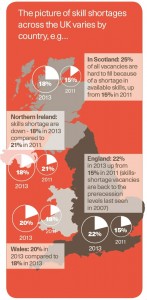UKCES makes connections between disparate ideas
UK Commission for Employment & Skills (UKCES) kicks off our new guest blog series, featuring Informed Scotland subscribers writing on the theme Making connections across the learning & skills landscape.
Creativity is making connections between disparate ideas. David Ogilvy, advertising magnate, built into his creative process time in which he ignored problems entirely, allowing his subconscious to churn over links and possible solutions. Five decades later, Steve Jobs agreed entirely, saying that “Creativity is just connecting things”. The first step for Ogilvy, and presumably Jobs as well, was to take in enough information – dots that could be drawn between with new insights.
So if your ideas are a product of the data you have – or in terms of your information diet, you are what you read – best then to ensure you refer to the highest quality sources available. How to judge quality? At the butcher, you might look at the cut, the marbling of fat, the colour of the meat. In the statistical world, you would be interested in the sample size, selection effects, and the quality of analysis.
This leads us to the UK Commission’s Employer Skills Survey (ESS), prime rib in a world of ground beef patty research. The survey takes a sample of over 91,000 establishments across the UK. That sample size is huge, allowing detailed interrogation of sectors and industries. The type, size, and location of interviews are carefully controlled to allow conclusions to be drawn about the overall business community. And the analysis is carried out by the government’s skills experts at UKCES.
The best part about the latest skills survey is that so much of the information from it is openly published, in open formats, ready to be combined and compared with other sources. While the insights from detailed reports are available, the underlying data tables can also be downloaded and examined in detail. We have also released the data in LMI for All, which brings together a range of different sources of labour market information in an online data portal.
So what else has the ESS data been combined with in practice?
The Financial Times combined it with information from the Higher Education Statistics Authority and the Office for National Statistics (ONS) to write and illustrate an article on skills shortages in engineering.
University Technical Colleges combined it with course information and advice from industry to identify areas of skills shortages and tailor the training programmes they offer.
Web developers Neon Tribe used it through LMI for All to create Careertrax, a careers guidance app.
There is so much data on tap that releases are happening in stages. The UK data was released at the end of January. Tailored data for local authorities and local enterprise partnerships in England came out in February, followed by Wales and Northern Ireland in June. Data, stats and graphics for Scotland will be launched in Glasgow on 7 July.
If you’re feeling intellectually undernourished, have a look at your data diet – ESS could be just what you need.
If the idea of a rich data source filling out your data diet appeals to you, consider the ways in which ESS could help.
For further information from UKCES contact: [email protected]. A link to the Scotland data release can be found here.
